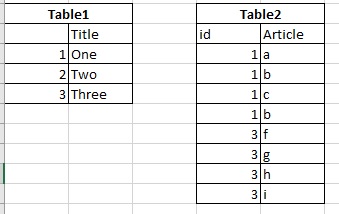Golang中如何实现这样的查询结果
Golang中如何实现这样的查询结果
var data = &a{
Title: []string{"One", "Two", "Three"},
Article: [][]string{
[]string{"a", "b", "c","b"},
[]string{},
[]string{"f", "g", "h", "i"}},
}
6 回复
抱歉,但我没理解你的示例。
你能添加一些格式让它更容易阅读吗?比如一些与你期望结果等价的代码,或者你尝试实现该结构的方式等等?
更多关于Golang中如何实现这样的查询结果的实战系列教程也可以访问 https://www.itying.com/category-94-b0.html
这是字段的更改

我不太确定先生,但我试图实现的是这样的…
标题:一
文章:a.
文章:b.
文章:c.
文章:b.
标题:二
标题:三
文章:f.
文章:g.
文章:h.
文章:i.
所以如果我理解正确的话,表1中的条目与表2存在一对多关系。
表2使用标题来引用表1,并且自身没有唯一标识符?
此外,您希望将表1的内容切片与表2的内容列表直接并列,并使用相同的索引来访问相关联的内容?
您应该立即停止并重新设计数据库。
- 在表2中使用适当的唯一ID,即使目前看起来没有必要
- 在表2中使用表1的ID作为外键,而不是标题
- 为单个条目使用结构体(例如
type Table1 struct {Title string; Article []Table2}(当然也需要正确定义Table2)) - 如果要查询表1的多个内容,请返回
[]Table1而不是您最初提议的结构
type Table1 struct {Title string; Article []Table2}
package main
import (
"html/template"
"os"
"fmt"
)
type a struct {
Title []string
Article [][]string
}
var data = &a{
Title: []string{"One", "Two", "Three"},
Article: [][]string{
[]string{"a", "b", "c","b"},
[]string{},
[]string{"f", "g", "h", "i"}},
}
var tmplSrc = `
{{range $i, $a := .Title}}
Title: {{$a}}
{{range $article := index $.Article $i}}
Article: {{$article}}.
{{end}}
{{end}}`
func main() {
fmt.Println(data)
tmpl := template.Must(template.New("test").Parse(tmplSrc))
tmpl.Execute(os.Stdout, data)
}
package main
import (
"html/template"
"os"
"fmt"
)
type a struct {
Title []string
Article [][]string
}
var data = &a{
Title: []string{"One", "Two", "Three"},
Article: [][]string{
[]string{"a", "b", "c","b"},
[]string{},
[]string{"f", "g", "h", "i"}},
}
var tmplSrc = `
{{range $i, $a := .Title}}
Title: {{$a}}
{{range $article := index $.Article $i}}
Article: {{$article}}.
{{end}}
{{end}}`
func main() {
fmt.Println(data)
tmpl := template.Must(template.New("test").Parse(tmplSrc))
tmpl.Execute(os.Stdout, data)
}
我想替换这个
var data = &a{
Title: []string{"One", "Two", "Three"},
Article: [][]string{
[]string{"a", "b", "c","b"},
[]string{},
[]string{"f", "g", "h", "i"}},
}
为SQL查询,表格如下所示

先谢谢了
在Go语言中,您提供的结构体定义和初始化方式可以通过结构体类型来实现。以下是一个完整的示例代码,展示如何定义结构体、初始化数据以及如何访问和打印这些数据:
package main
import "fmt"
// 定义结构体类型
type a struct {
Title []string
Article [][]string
}
func main() {
// 初始化结构体
var data = &a{
Title: []string{"One", "Two", "Three"},
Article: [][]string{
{"a", "b", "c", "b"},
{},
{"f", "g", "h", "i"},
},
}
// 访问和打印数据
fmt.Println("Titles:")
for i, title := range data.Title {
fmt.Printf(" %d: %s\n", i, title)
}
fmt.Println("\nArticles:")
for i, article := range data.Article {
fmt.Printf(" %d: %v\n", i, article)
}
// 访问特定元素示例
fmt.Printf("\nFirst title: %s\n", data.Title[0])
fmt.Printf("Second article: %v\n", data.Article[1])
fmt.Printf("Third article's first element: %s\n", data.Article[2][0])
}
运行此代码将输出:
Titles:
0: One
1: Two
2: Three
Articles:
0: [a b c b]
1: []
2: [f g h i]
First title: One
Second article: []
Third article's first element: f
这个示例展示了:
- 使用结构体类型
a来组织标题和文章数据 - 使用切片来存储字符串数组
- 通过指针
&a{}来创建结构体实例 - 使用循环遍历和访问切片中的元素
- 演示了如何访问特定的数组元素
如果您需要进一步处理这些数据,比如查询、过滤或转换,可以根据具体需求添加相应的逻辑。






